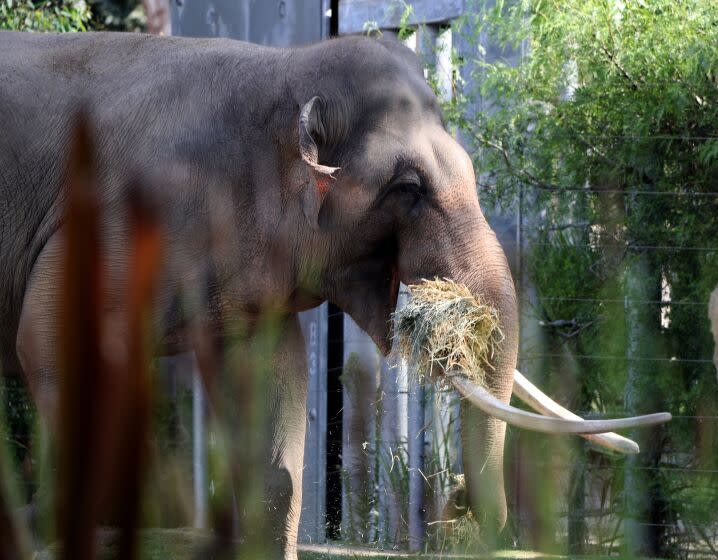Letters to the Editor: Free Billy the elephant from the L.A. Zoo now. His life is at stake

To the editor: In 2006, the then-director of the Los Angeles Zoo testified to the City Council that Gita the elephant was in good health. Two months later, she died of ailments related to the size and quality of her exhibit. ("Free Billy! L.A. Zoo’s longtime elephant has earned retirement," editorial, Dec. 5)
Billy is now demonstrating the exact same problems.
The Performing Animal Welfare Society (PAWS) sanctuary in Northern California has 15 acres of soft earth, trees and lakes waiting for Billy so he can heal. In 2007, Ruby the elephant was sent from the L.A. Zoo to the PAWS sanctuary. There was no question about whether it was accredited by the Assn. of Zoos and Aquariums, something the zoo now says it wants for whatever facility Billy is sent to.
Since the L.A. Zoo has already sent an elephant to PAWS, there is no reason why it should not send Billy.
Melya Kaplan, Santa Monica
The writer is founder and executive director of Voice for the Animals.
..
To the editor: I find myself unwilling to visit the zoo to see intelligent and social beings like Billy locked up and becoming stressed and likely depressed as well.
I had the opportunity to see large herds of elephants in Amboseli National Park in Kenya. It was apparent that they enjoyed both familial and extended social relationships.
Watching them gave me so much pleasure. I learned they experience grief, returning to places where other elephants died. It was obvious they show protective behavior of their offspring.
A zoo is no place for these and other intelligent, social beings.
Peter Ambrose, Claremont
..
To the editor: You and every other elephant savior say Billy is stressed. Where do you get your information? The activists who periodically show up to protest at the zoo?
The zoo's medical personnel give excellent care to Billy and say his head bobbing is a peculiarity that he often exhibits when he sees his keeper.
Billy's exhibit gives him plenty of room to move around. His keepers make sure he walks. Who is to say that at a sanctuary Billy would take advantage of the space and walk around?
Councilman Paul Koretz's recent motion to remove Billy is his third such attempt in the last 13 years. Prior attempts have failed, and so will this one.
Leave Billy at the L.A. Zoo as an ambassador for campaigns to end wild elephant poaching, a role in which he can do a lot of good.
Gerald Orcholski, Pasadena
..
To the editor: I appreciate your editorial, but I am again left to wonder if there is real leadership on the L.A. City Council.
A highly social, sentient and long-lived animal remains in the L.A. Zoo in spite of overwhelming and conclusive evidence that no city zoo, no matter how well-intentioned or well-funded, can provide adequately for such a large animal.
Zoos cannot justify keeping captive elephants on the basis of education. Take a look for yourself. What can be learned? Any such claims of educational merit are educational malpractice, pure and simple.
Morgan Schwartz, Culver City
This story originally appeared in Los Angeles Times.

